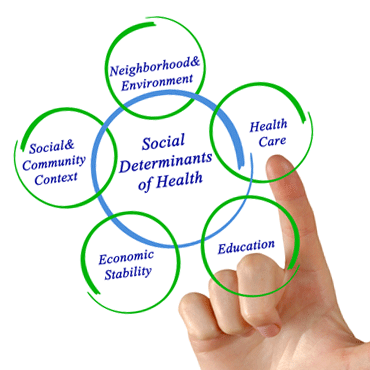
Community developers and health professionals often work in the same neighborhoods with the same residents, but they rarely work together in an integrated way to improve people's health and economic outcomes. That is starting to change. In a new discussion paper, the Atlanta Fed looks at emerging health and community development partnerships in the Southeast. These partnerships are driven, in part, by the health sector's recognition that clinical care accounts for only 20 percent of health outcomes (see chart 1). Instead, factors like income and housing ultimately drive health outcomes. Partnering with community developers offers the health sector the ability to address the social determinants of health.
The paper offers in-depth case studies of collaborations in the Southeast that are centered on improving the social determinants of health, including:
- A hospital system in Florida that made a $6 million grant investment in affordable housing
- A community development financial institution that is helping address access to care, food deserts, and healthy eating
- State Medicaid officials in South Carolina and Tennessee that use Pay for Success finance both to improve outcomes for Medicaid recipients and control Medicaid costs.

Why partner?
For health stakeholders, community developers can serve as both a disruptive and constructive force in efforts to drive improvements in the health care system's ability to address the social determinants of health, control spending, and improve quality of care. Community developers' expertise in crafting multi-sector, public-private partnerships that invest in community-driven projects is powerful. Community developers can devise ways to fund these partnerships through mixing public, philanthropic, and private capital. In this way, community developers can blend market discipline with social purpose. Their expertise in integrating the community's voice into a given project means community developers know how to build trust with the populations the health sector may be trying to reach. Finally, community developers know how to intervene in the social, economic, and built environment factors that research shows ultimately drive population-level health outcomes.
Community developers are learning that health stakeholders can be powerful allies at the local level. Hospitals and health insurers can become a source of grant or investment capital for community development deals. They are also often an influential civic voice, given health care's role as a leading employer in many regions. In addition, the health care sector can be a source of service contracts for nonprofit service providers, offering a possible new source of funding to this sector.
Local governments and philanthropy are recognizing the value of health and community development partnerships. Funding cross-sector collaborations can help governmental actors overcome their own bureaucratic silos and meet fiscal efficiency goals. Medicaid is often the system that most benefits from such collaboration, and its various waiver programs offer states flexibility to experiment with collaboration. Local government can also be a key supporter of these cross-sector innovations, including through leveraging its convening power, as Baton Rouge has shown.
Local governments and philanthropy are recognizing the value of health and community development partnerships. Funding cross-sector collaborations can help governmental actors overcome their own bureaucratic silos and meet fiscal efficiency goals. Medicaid is often the system that most benefits from such collaboration, and its various waiver programs offer states flexibility to experiment with collaboration. Local government can also be a key supporter of these cross-sector innovations, including through leveraging its convening power, as Baton Rouge has shown.
Moving forward
The Southeast stands as fertile ground for health and community development collaborations, with an array of poor economic and health indicators across urban, suburban, and rural markets. A recent survey found 65 percent of cross-sector collaborations in health started after 2010, so the field is still in its infancy. To be successful, cross-sector collaboration must address their differences in cultures, languages, and goals (see chart 2). Early innovators have overcome these challenges by hiring a coordinator to manage the collaboration, using data to promote transparency and accountability, and establishing financing and payment mechanisms that support collaboration.

By Sameera Fazili, senior CED adviser



